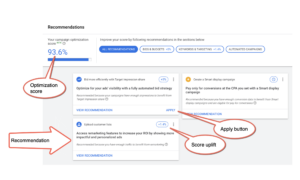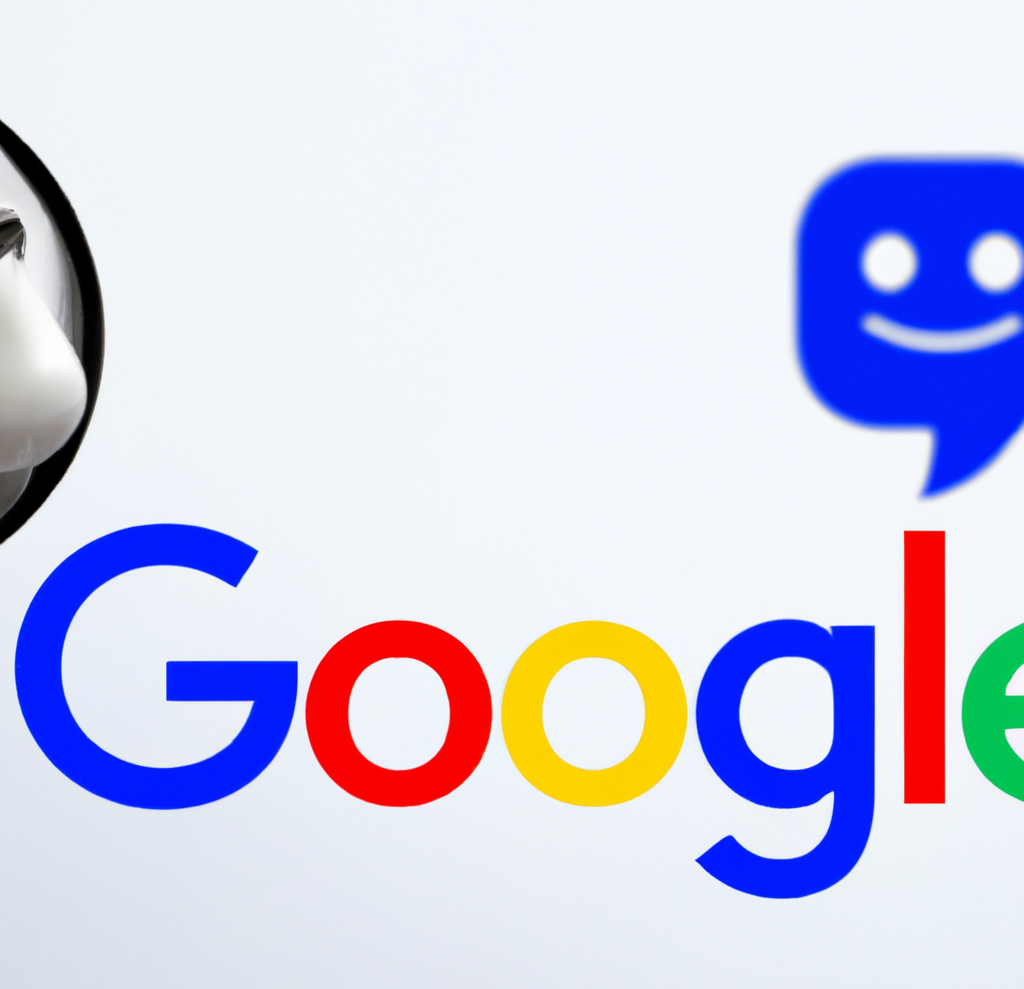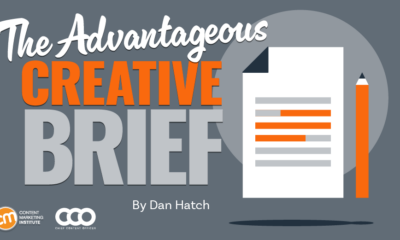Do You Really Want a 100% Google Ads Optimization Score?

It isn’t unusual for companies to offer free online PPC analysis tools.
So perhaps it isn’t surprising that Google itself got into that game in 2018.
Google Ads has a built-in feature that provides users with an optimization score and recommendations to improve it.
This sounds good in theory.
But what would happen if you applied Google’s recommendations across the board?
This question came up recently when a client came to us with a new goal. He wanted to get his Google Ads optimization score to 100%.
This isn’t something we typically hear from clients.
We cautioned him that we would need to go slow. His account has over 200 campaigns, and we would start with only a few.
Why our hesitation?
Because whenever we’ve implemented Google Ads recommendations in the past, we’ve had mixed results.
Nevertheless, our client was determined to meet this new goal, so we took a stab at it.
In this article, I describe how it went.
What Is Google Ads Optimization Score?
Before we dig into our findings, let’s have a short refresher on Google Ads optimization.
Google describes its optimization score as an estimate of how well your Google Ads account is set to perform.
You can score anywhere between 0 to 100%, with 100 meaning that your account can perform at its full potential.
Your optimization scores are available at the campaign, account, and manager account levels. It is shown for active Search, Shopping and Display campaigns.
Since its rollout, Google has continued to expand on this feature, including adding recommendations to improve your score.
In your account, it looks something like this:

As you can see, each recommendation comes with a “score uplift” which reflects the estimated impact of the recommendation if made.
Some recommendations also come with APPLY buttons, which automatically apply the recommendation to your account.
Now let’s take a closer look at the recommendations we received for our client’s account.
Recommendation 1: Add Price Extensions
Adding price extensions was an interesting suggestion and not something we had considered.
Usually, price extensions are used by retail stores, which our client is not.
Our client provides at-home euthanasia services for ailing pets, which hardly seems like a natural fit for price extensions.
Besides, up to this point, our client had resisted adding pricing to his ads.
Based on increased competition within this space, we decided to test adding pricing to this client’s ad messaging to better qualify people going to his website.
Depending on how that goes, we may very well implement price extensions.
So in this case, Google’s recommendation was a good one (at least potentially).
Recommendation 2: Use Customer Lists
Customer lists isn’t a marketing method we would have normally considered for this account.
After all, would we really want to retarget customers who had gone through the painful process of putting down a pet?
Of course not. That would be horrible!
However, Google does allow you to target similar audiences, which sounds like it could actually work.
The idea is intriguing. We haven’t tested it yet, but we haven’t written it off either.
Recommendation 3: Apply Dynamic Search Ads
Google also recommended applying dynamic search ads.
Dynamic search ads seemed a bit out of the box for this account, but we decided to test it in one campaign.
So far, the dynamic search ads are performing well.
This was surprising, given that dynamic search ads are geared to advertisers that have a large inventory of products to sell, such as healthcare supplies or car parts.
Indeed, Google describes dynamic search ads as:
“…ideal for advertisers with a well-developed website or a large inventory… Dynamic Search Ads use your website content to target your ads and can help fill in the gaps of your keyword-based campaigns.”
That doesn’t sound like a fit for our client, who offers exactly one service.
I do wonder if these automated ad creatives are cannibalizing our other ad groups. (Indeed, we have seen a drop in performance in those groups.)
I also wonder if performance would remain as strong if we were to implement dynamic search ads across multiple campaigns.
With all these unknowns, we’re going to move slowly on the implementation of this recommendation while continuing to monitor and test.
Recommendation 4: Apply Automated Bidding
Here’s where Google lost us.
Every campaign in our client’s account (of which there are over 200) comes with a recommendation to apply automated bidding.
I guarantee that if we implemented automated bidding across the board, our client’s spending would go through the roof.
Instead, we proceeded cautiously and tested automated bidding in only one of our client’s campaigns. As a result, we saw a 47% increase in spend.
If we were to multiply this increase across 200-plus campaigns, that’s a big-ticket item – and something our client wouldn’t appreciate, even if his optimization score hit 100%.
100% Optimization Shouldn’t Be the Goal
All of this leads us to the question:
Is a 100% optimization score a good or useful goal?
I would say not.
Most of our accounts have an average optimization score of around 80%, which sounds right to me.
Sure, you could try to push it higher. But you’ll likely blow a hole in your advertising budget in the process.
That’s not to say that Google’s optimization score is useless. It did give us some useful hints and out-of-the-box suggestions, which was great.
I could also see it coming in handy when auditing a new account with a low optimization score. It could be a fast and easy way to identify the most obvious problems.
The main takeaway here?
As always, whenever Google recommends something, don’t trust it. Test it.
Because while Google’s artificial intelligence might be smart, it doesn’t know you or your business.
And that’s what makes the human touch so critical – even in 2020.
More Resources:
- Google’s Best Practices for Improving Your Google Ads Optimization Score
- 10 Paid Search & PPC Best Practices for 2020
- PPC 101: A Complete Guide to PPC Marketing Basics
Image Credits
Featured Image: Dreamstime.com
Screenshot taken by author, December 2019
AI
Exploring the Evolution of Language Translation: A Comparative Analysis of AI Chatbots and Google Translate

According to an article on PCMag, while Google Translate makes translating sentences into over 100 languages easy, regular users acknowledge that there’s still room for improvement.
In theory, large language models (LLMs) such as ChatGPT are expected to bring about a new era in language translation. These models consume vast amounts of text-based training data and real-time feedback from users worldwide, enabling them to quickly learn to generate coherent, human-like sentences in a wide range of languages.
However, despite the anticipation that ChatGPT would revolutionize translation, previous experiences have shown that such expectations are often inaccurate, posing challenges for translation accuracy. To put these claims to the test, PCMag conducted a blind test, asking fluent speakers of eight non-English languages to evaluate the translation results from various AI services.
The test compared ChatGPT (both the free and paid versions) to Google Translate, as well as to other competing chatbots such as Microsoft Copilot and Google Gemini. The evaluation involved comparing the translation quality for two test paragraphs across different languages, including Polish, French, Korean, Spanish, Arabic, Tagalog, and Amharic.
In the first test conducted in June 2023, participants consistently favored AI chatbots over Google Translate. ChatGPT, Google Bard (now Gemini), and Microsoft Bing outperformed Google Translate, with ChatGPT receiving the highest praise. ChatGPT demonstrated superior performance in converting colloquialisms, while Google Translate often provided literal translations that lacked cultural nuance.
For instance, ChatGPT accurately translated colloquial expressions like “blow off steam,” whereas Google Translate produced more literal translations that failed to resonate across cultures. Participants appreciated ChatGPT’s ability to maintain consistent levels of formality and its consideration of gender options in translations.
The success of AI chatbots like ChatGPT can be attributed to reinforcement learning with human feedback (RLHF), which allows these models to learn from human preferences and produce culturally appropriate translations, particularly for non-native speakers. However, it’s essential to note that while AI chatbots outperformed Google Translate, they still had limitations and occasional inaccuracies.
In a subsequent test, PCMag evaluated different versions of ChatGPT, including the free and paid versions, as well as language-specific AI agents from OpenAI’s GPTStore. The paid version of ChatGPT, known as ChatGPT Plus, consistently delivered the best translations across various languages. However, Google Translate also showed improvement, performing surprisingly well compared to previous tests.
Overall, while ChatGPT Plus emerged as the preferred choice for translation, Google Translate demonstrated notable improvement, challenging the notion that AI chatbots are always superior to traditional translation tools.
Source: https://www.pcmag.com/articles/google-translate-vs-chatgpt-which-is-the-best-language-translator
Google Implements Stricter Guidelines for Mass Email Senders to Gmail Users

Beginning in April, Gmail senders bombarding users with unwanted mass emails will encounter a surge in message rejections unless they comply with the freshly minted Gmail email sender protocols, Google cautions.
Fresh Guidelines for Dispatching Mass Emails to Gmail Inboxes In an elucidative piece featured on Forbes, it was highlighted that novel regulations are being ushered in to shield Gmail users from the deluge of unsolicited mass emails. Initially, there were reports surfacing about certain marketers receiving error notifications pertaining to messages dispatched to Gmail accounts. Nonetheless, a Google representative clarified that these specific errors, denoted as 550-5.7.56, weren’t novel but rather stemmed from existing authentication prerequisites.
Moreover, Google has verified that commencing from April, they will initiate “the rejection of a portion of non-compliant email traffic, progressively escalating the rejection rate over time.” Google elaborates that, for instance, if 75% of the traffic adheres to the new email sender authentication criteria, then a portion of the remaining non-conforming 25% will face rejection. The exact proportion remains undisclosed. Google does assert that the implementation of the new regulations will be executed in a “step-by-step fashion.”
This cautious and methodical strategy seems to have already kicked off, with transient errors affecting a “fraction of their non-compliant email traffic” coming into play this month. Additionally, Google stipulates that bulk senders will be granted until June 1 to integrate “one-click unsubscribe” in all commercial or promotional correspondence.
Exclusively Personal Gmail Accounts Subject to Rejection These alterations exclusively affect bulk emails dispatched to personal Gmail accounts. Entities sending out mass emails, specifically those transmitting a minimum of 5,000 messages daily to Gmail accounts, will be mandated to authenticate outgoing emails and “refrain from dispatching unsolicited emails.” The 5,000 message threshold is tabulated based on emails transmitted from the same principal domain, irrespective of the employment of subdomains. Once the threshold is met, the domain is categorized as a permanent bulk sender.
These guidelines do not extend to communications directed at Google Workspace accounts, although all senders, including those utilizing Google Workspace, are required to adhere to the updated criteria.
Augmented Security and Enhanced Oversight for Gmail Users A Google spokesperson emphasized that these requisites are being rolled out to “fortify sender-side security and augment user control over inbox contents even further.” For the recipient, this translates to heightened trust in the authenticity of the email sender, thus mitigating the risk of falling prey to phishing attempts, a tactic frequently exploited by malevolent entities capitalizing on authentication vulnerabilities. “If anything,” the spokesperson concludes, “meeting these stipulations should facilitate senders in reaching their intended recipients more efficiently, with reduced risks of spoofing and hijacking by malicious actors.”
Google’s Next-Gen AI Chatbot, Gemini, Faces Delays: What to Expect When It Finally Launches

In an unexpected turn of events, Google has chosen to postpone the much-anticipated debut of its revolutionary generative AI model, Gemini. Initially poised to make waves this week, the unveiling has now been rescheduled for early next year, specifically in January.
Gemini is set to redefine the landscape of conversational AI, representing Google’s most potent endeavor in this domain to date. Positioned as a multimodal AI chatbot, Gemini boasts the capability to process diverse data types. This includes a unique proficiency in comprehending and generating text, images, and various content formats, even going so far as to create an entire website based on a combination of sketches and written descriptions.
Originally, Google had planned an elaborate series of launch events spanning California, New York, and Washington. Regrettably, these events have been canceled due to concerns about Gemini’s responsiveness to non-English prompts. According to anonymous sources cited by The Information, Google’s Chief Executive, Sundar Pichai, personally decided to postpone the launch, acknowledging the importance of global support as a key feature of Gemini’s capabilities.
Gemini is expected to surpass the renowned ChatGPT, powered by OpenAI’s GPT-4 model, and preliminary private tests have shown promising results. Fueled by significantly enhanced computing power, Gemini has outperformed GPT-4, particularly in FLOPS (Floating Point Operations Per Second), owing to its access to a multitude of high-end AI accelerators through the Google Cloud platform.
SemiAnalysis, a research firm affiliated with Substack Inc., expressed in an August blog post that Gemini appears poised to “blow OpenAI’s model out of the water.” The extensive compute power at Google’s disposal has evidently contributed to Gemini’s superior performance.
Google’s Vice President and Manager of Bard and Google Assistant, Sissie Hsiao, offered insights into Gemini’s capabilities, citing examples like generating novel images in response to specific requests, such as illustrating the steps to ice a three-layer cake.
While Google’s current generative AI offering, Bard, has showcased noteworthy accomplishments, it has struggled to achieve the same level of consumer awareness as ChatGPT. Gemini, with its unparalleled capabilities, is expected to be a game-changer, demonstrating impressive multimodal functionalities never seen before.
During the initial announcement at Google’s I/O developer conference in May, the company emphasized Gemini’s multimodal prowess and its developer-friendly nature. An application programming interface (API) is under development, allowing developers to seamlessly integrate Gemini into third-party applications.
As the world awaits the delayed unveiling of Gemini, the stakes are high, with Google aiming to revolutionize the AI landscape and solidify its position as a leader in generative artificial intelligence. The postponed launch only adds to the anticipation surrounding Gemini’s eventual debut in the coming year.
-
SEARCHENGINES7 days ago
Daily Search Forum Recap: April 29, 2024
-
SEARCHENGINES6 days ago
Daily Search Forum Recap: April 30, 2024
-

 MARKETING6 days ago
MARKETING6 days agoHow To Develop a Great Creative Brief and Get On-Target Content
-

 SEO7 days ago
SEO7 days agoGoogle’s John Mueller On Website Recovery After Core Updates
-

 WORDPRESS6 days ago
WORDPRESS6 days ago13 Best Fun WordPress Plugins You’re Missing Out On
-

 SEO5 days ago
SEO5 days agoWhy Big Companies Make Bad Content
-

 SEO5 days ago
SEO5 days agoHow To Drive Pipeline With A Silo-Free Strategy
-

 SEO6 days ago
SEO6 days agoOpenAI To Show Content & Links In Response To Queries




You must be logged in to post a comment Login